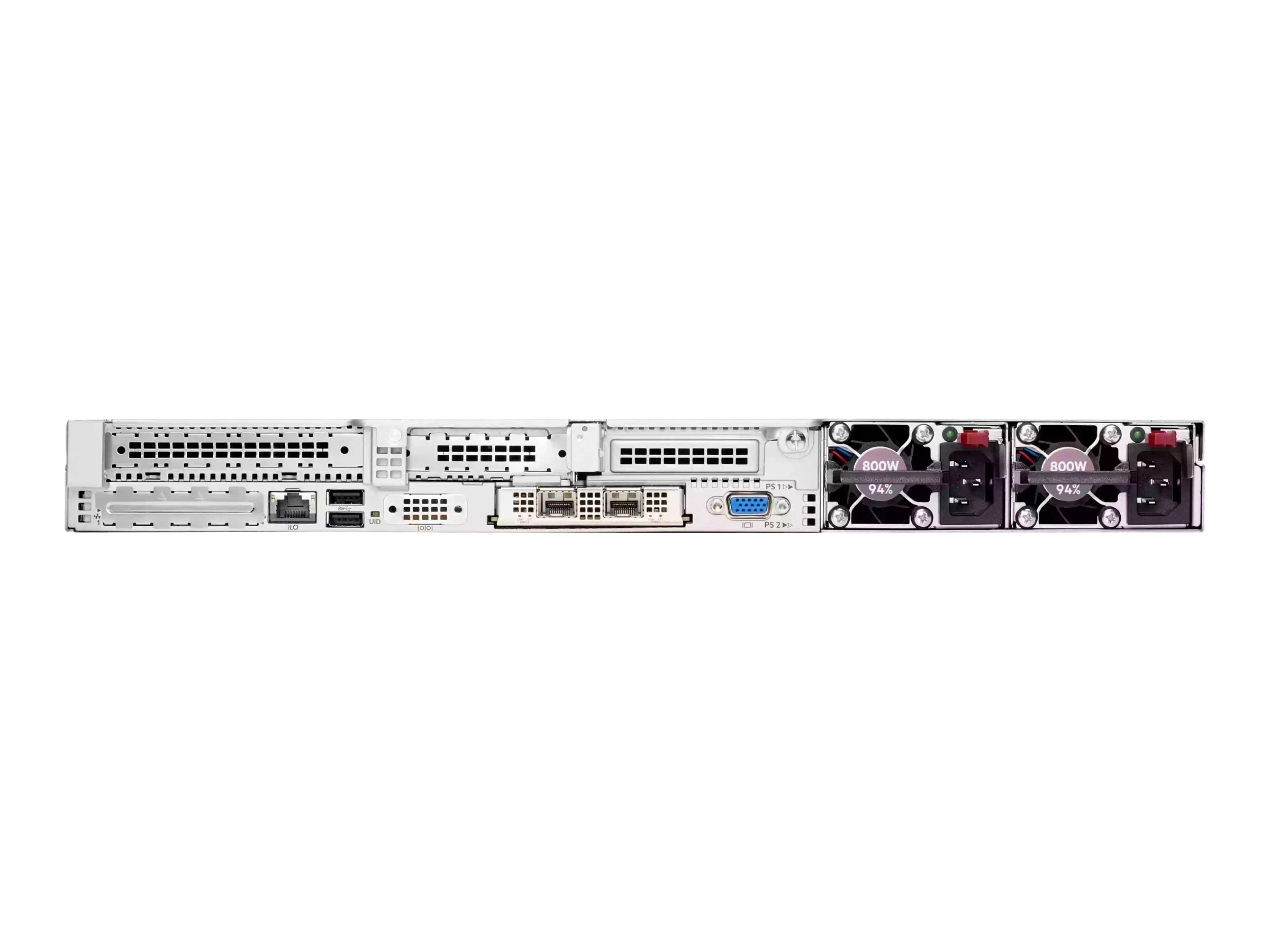Key Features That Support Lower Power Consumption
HPE ProLiant DL365 Gen10 Plus is an astute option for data centers looking to save energy. It packs a punch in a small 1U rack, using HPE ProLiant technology, the shared architecture for hybrid clouds. With AMD EPYC 7003 series processors, it operates quickly in an extremely small footprint. This density strategy cuts power and space consumption compared to traditional large servers.
It can support 128 cores and 32 DIMM slots of memory at 3200 MHz. You get to cram lots of workloads into fewer boxes. Fewer servers mean less juice, cooling, and gear to contend with. You get affordable virtual machines (VMs) with best-in-class security, saving power while keeping things fast.
How Intelligent Power Management Improves Operational Efficiency
The HPE ProLiant DL365 Gen10 Plus has smart automation that slashes energy waste. It optimizes management work, so it is a good foundation for hybrid cloud environments. The server delivers real-time performance feedback and suggests BIOS settings to handle workload demands. It adjusts to run without sipping power.
Besides, it features redundant power supplies that are hot-swappable and reach up to 96% titanium-level efficiency. This keeps energy consumption to minimal and steady levels, keeping downtime risks at almost zero. It’s like a power-sipping champ that never quits.

The Role of AMD EPYC Processors in Reducing Energy Use
At its core, the HPE ProLiant DL365 Gen10 Plus rocks AMD EPYC 7003 series processors, with up to 64 cores per CPU and 280W power. These chips handle tons of tasks at once without needing extra hardware or juice. More workloads per socket mean less power overall.
The AMD Secure Processor, baked into the chip, handles secure boot and virtualization without extra gear. Paired with Silicon Root of Trust, it ensures secure boot, memory encryption, and safe virtualization, all while keeping energy use lean.
How Does the HPE ProLiant DL365 Gen10 Plus Optimize Cooling in High-Density Environments?
Advanced Thermal Controls for Better Heat Dissipation
In packed data centers, heat can mess things up. The HPE ProLiant DL365 Gen10 Plus tackles this with clever cooling tricks. It has six standard or high-performance fans that adjust speeds based on workload. These hot-swappable redundant fans keep airflow just right without wasting power when full blast isn’t needed.
This smart setup prevents overheating, even in tight spaces, keeping performance steady and systems happy.
Smart Fan Technologies and Their Impact on Power Usage
The server’s fan control algorithms are super savvy. They tweak fan speeds using temperature sensors across the chassis. This cuts unnecessary fan spinning, saving power and extending fan life. It’s like turning down the AC when it’s cool enough—smart and thrifty.
With its compact design and efficient layout, these cooling features keep temperatures in check under heavy loads, slashing total energy use.
Rack Configuration Tips to Maximize Cooling Efficiency
For top cooling in dense setups, place the HPE ProLiant DL365 Gen10 Plus in racks with front-to-back airflow. Use blanking panels between units to stop hot air from looping back. Also, keep enough space between rack rows for cold aisle/hot aisle setups. This keeps the cool air flowing where it’s needed.
At Huaying Hengtong, our pre-sales pros can guide you on rack layouts tailored to your needs, ensuring your setup stays cool and efficient.
In What Ways do the HPE ProLiant DL365 Gen10 Plus vs Dell PowerEdge R7525 Compare on Energy Performance?
Comparing Power Efficiency Ratings and Certifications
Both the HPE ProLiant DL365 Gen10 Plus and Dell PowerEdge R7525 use high-efficiency titanium-rated power supplies. But HPE’s 1U design and built-in automation tools give it a leg up. These tools actively manage energy across components, making it a leaner choice.
Dell’s R7525, with its 2U chassis, often needs more cooling than HPE’s slim 1U setup, which saves on power for cooling.
Hardware-Level Energy Optimization: HPE vs Dell
HPE’s Silicon Root of Trust is woven into the firmware, boosting security and cutting energy use during boot and idle times. It ensures the server starts its lifecycle through a secure supply chain, verified for integrity. This smart setup optimizes energy at every step, unlike Dell’s reliance on OS-level tweaks.
This gives HPE an edge in making energy-smart choices from startup to heavy workloads.
Software Tools for Energy Monitoring: iLO vs iDRAC
HPE’s Integrated Lights-Out (iLO) platform is a powerhouse for energy tracking. It offers thermal mapping, per-component power metering, historical trends, and automated alerts, all accessible via mobile apps or web dashboards. It ties into tools like HPE OneView for centralized control over multiple servers’ energy profiles.
Dell’s iDRAC is solid, but iLO’s deeper integration with enterprise tools gives HPE a slight advantage for managing energy across big setups.

Why Is the HPE ProLiant DL365 Gen10 Plus Ideal for Virtualization and Workload Consolidation?
Energy Savings Through Higher Core Density and Virtualization
Virtualization loves multi-core setups, and the HPE ProLiant DL365 Gen10 Plus shines with up to two AMD EPYC CPUs, packing 128 cores total. It supports up to 128 lanes of PCIe Gen4, boosting I/O speed and cutting latency. This means you can run tons of VMs efficiently.
More cores per unit let you consolidate workloads, slashing the need for extra servers and saving big on power.
How Consolidating Workloads Reduces Overall Power Demand
With high compute density and up to 32 DIMM slots, this server hosts more apps per node. You can retire old, power-hungry servers, freeing up rack space and cutting electricity use for both computing and cooling. It’s like moving a whole office into a single, efficient room.
This approach saves energy across your data center, making it a green win.
Balancing Performance with Power Draw in Virtual Environments
The server’s real-time BIOS tuning suggestions balance workload needs with resources. It gives feedback on performance and tweaks BIOS for custom fits to business demands. Whether running VMware ESXi or Microsoft Hyper-V, it ensures max VM density without stability issues or overheating.
This keeps your virtual setups humming without wasting power.
Who Is Huaying Hengtong and How Do We Support Your Data Center Needs?
Our Commitment to Providing Genuine HPE ProLiant DL365 Gen10 Plus Servers
At Huaying Hengtong, we deliver authentic servers, sourced straight from authorized channels. Every unit meets factory specs with full warranty coverage. We’re all about trust, ensuring you get the real deal for your data center.
Value-Added Services Including Pre-Sales Consultation and After-Sales Support
We go beyond selling hardware. Our pre-sales team helps with compatibility checks, like ensuring AMD EPYC 7003 series CPUs or DDR4 ECC RDIMMs work perfectly. We assist with deployment, like setting up RAID with Tri-Mode Storage Controllers. After-sales, we offer firmware update guidance, troubleshooting with certified pros, and iLO setup help.
Why Customers Trust Huaying Hengtong for Reliable Server Solutions
Clients love us for our tech know-how and quick support. Whether you’re growing virtualization or building a new data center, we tailor solutions on platforms like the HPE ProLiant DL365 Gen10 Plus. Our scalable, reliable configurations address your needs, from small scale-ups to big deployments.
FAQ
Q: What makes a high-density server more energy-efficient than traditional models?
A: High-density servers like the 1U HPE ProLiant DL365 Gen10 Plus use less space per workload, cutting cooling needs and boosting core-per-watt efficiency.
Q: How does virtualization contribute to lower energy usage?
A: Virtualization runs multiple workloads on one machine, reducing the hardware footprint and power used for computing and cooling.
Q: Can I monitor energy usage remotely on my servers?
A: Yup. HPE iLO offers remote tools to track real-time power use, historical trends, and optimization insights per component.
Q: What type of processors are compatible with this model?
A: The HPE ProLiant DL365 Gen10 Plus supports AMD EPYC 7003 series processors, with up to 64 cores per CPU.
Q: Are titanium-rated PSUs worth it?
A: Totally. Titanium-rated power supplies hit over 96% efficiency, saving on electricity bills, especially in large data centers.











